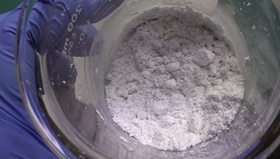Silver acetate
 Silver acetate
| |
| Names | |
|---|---|
| IUPAC name
Silver acetate
| |
| Other names
Acetic acid, silver (1+) salt
Silver(I) acetate Silver ethanoate | |
| Properties | |
| AgC2H3O2 CH3COOAg | |
| Molar mass | 166.912 g/mol |
| Appearance | White solid |
| Density | 3.26 g/cm3 |
| Melting point | 220 °C (428 °F; 493 K) (decomposition) |
| Boiling point | Decomposes |
| 1.02 g/100 ml (20 °C) | |
| Solubility | Insoluble in benzene |
| Vapor pressure | ~0 mmHg |
| Hazards | |
| Safety data sheet | Sigma-Aldrich |
| Lethal dose or concentration (LD, LC): | |
| LD50 (Median dose)
|
36.7 mg/kg (mouse, oral) |
| Related compounds | |
| Related compounds
|
Copper(II) acetate Zinc acetate |
| Except where otherwise noted, data are given for materials in their standard state (at 25 °C [77 °F], 100 kPa). | |
| Infobox references | |
Silver acetate is a silver compound with the chemical formula CH3COOAg. It is one of the few common acetate salts that are poorly soluble in water.
Contents
[hide]Properties
Chemical
Silver acetate decomposes when heated to give acetone, carbon dioxide, oxygen and silver metal, with traces of water and other organic side products.
- 2 CH3COOAg → 2 Ag + (CH3)2CO + CO2 + ½ O2
Physical
Silver acetate is a white solid, poorly soluble in water.
Availability
Silver acetate is sold by various chemical suppliers.
Preparation
Silver acetate can be made by the reaction of glacial acetic acid and silver carbonate, at 45–60 °C. After the reaction has completed, cool the solution to precipitate the silver acetate.
- 2 CH3CO2H + Ag2CO3 → 2 CH3COOAg + H2O + CO2
Another route involves mixing two concentrated solutions of silver nitrate and sodium acetate. Silver acetate precipitates, while sodium nitrate stays in solution. Filter the poorly soluble silver acetate, then wash it with cold distilled water, and let it dry.[1] Avoid doing this reaction in strong light.
Projects
- Make conductive silver ink
- Hunsdiecker reaction
- Carbonylate primary and secondary amines.
Handling
Safety
Silver compounds are harmful and tend to stain. Wear proper protection when handling them.
Storage
In closed plastic or glass containers, away from light and acids.
Disposal
Can be reduced to elemental silver, which can be recycled.